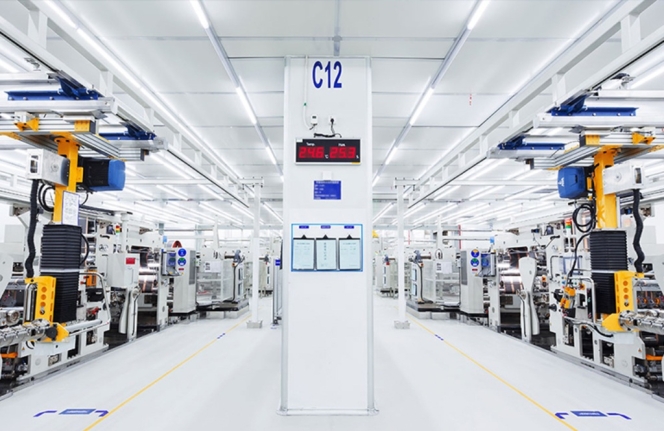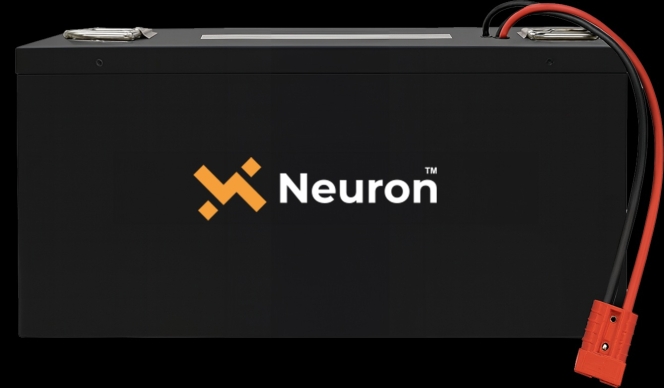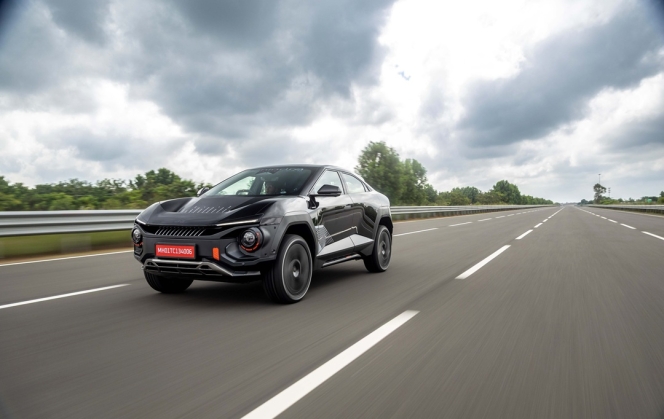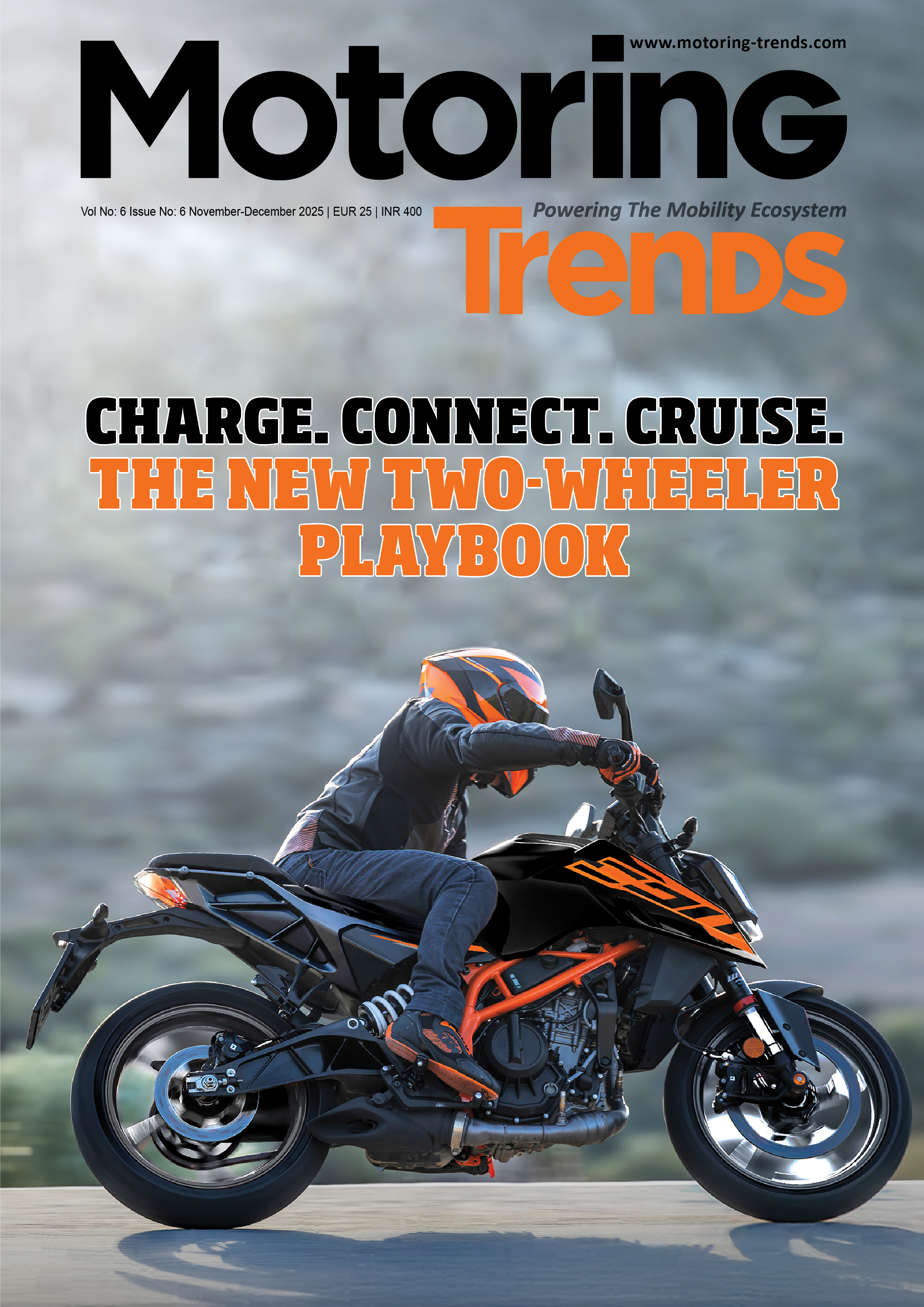Working Towards An Electrified Future
- By Juili Eklahare
- June 23, 2022

Tesla may not be the only game-changer in the electric vehicle space anymore. We see many other manufacturers taking huge leaps in the sector, even in India – what with Tata Motors and its Nexon EV ruling a majority of the EV space, or Mahindra, who announced that a fully electric version of its popular XUV300 SUV will be launched in the second half of next year.
Just like the global automotive market, the Indian automotive market is also going through a transition, and India is just at the beginning of this transition. We currently see electric two- and three-wheelers having great acceptance, which we will eventually see happening in the light vehicle market as well. As for four-wheelers, we are at the start of this transition. In that sense, both the passenger vehicle and small and light commercial vehicle segments will experience electrification eventually. However, the rate at which this happens will be slightly slower as compared to two- and three-wheelers because 80 percent of our market is A and B segment.
In terms of two- and three-wheelers, the upfront cost, which has been a big hurdle for EV acceptance, has been taken care of by several government subsidies and the special GST rate that they get. Moreover, the government also supports in terms of direct consumer incentive provided to the customers/buyers.
Another factor that is, in fact, proving to be of help is the rising price of fuel, Suraj Ghosh, Director – Powertrain research and analysis, S&P Global Mobility, tells us. “As the prices of fuel rise, customers are looking for cheaper alternatives. But we must remember that unless the upfront cost has been taken care of, the acceptance of EVs might still be difficult,” he says.
The challenges
From the supply side, the supply chain for batteries is still not very smooth. Therefore, sourcing batteries that are of good quality is a big challenge for the EV ecosystem right now. “We don’t have the raw material needed for manufacturing EV batteries or cells. The cell production capacity is not available locally and so, it has to be sourced from countries like China, South Korea, Japan, Taiwan etc., making us dependent in that sense,” Ghosh informs.
As for the manufacturers (again, from the supply side), there isn’t much clarity on long-term policies. Right now, the FAME scheme supports EV promotion. However, it has an expiry year of 2024. That raises the question of what happens after that. Will there be a new FAME scheme? Or will the government continue to support the EV ecosystem like it is now? Hence, due to the lack of such clarity, manufacturers are being slightly cautious and are hesitant when it comes to investments in EV manufacturing setups, Ghosh says.
Currently, the lithium-ion batteries used in EVs have different battery chemistries and certain raw materials involved. “Forming collaborations, joint ventures and technological partnerships with companies that work in the upstream segment of mining operations of those raw materials can play a very key part in India’s future of electrification,” Ghosh asserts. He adds, “In fact, Indian OEMs can form a sort of consortium and collectively bargain for raw materials or other key components that go into EVs. This can turn out to be a good initiative by Indian OEMs.”
Ghosh further informs that from the demand side, there are not many consumers in India who would happily pay premium for a vehicle just because it’s electric – this isn’t something that will happen overnight. Another challenge that comes to light is parity – in terms of price, convenience and range.
The consumer
Ghosh also believes that the upcoming battery electric vehicles in India are being made keeping a price-conscious customer in mind. He further explains, “When we say EVs, we always talk about range. We cannot have a huge battery pack in our car, because then that would increase the cost. And an increase in cost results in isolating a huge segment of the market that can’t afford that car. Therefore, we have to strike a balance between the range and price of the car, where it becomes affordable and satisfactory in terms of the range. Therefore, this is something that OEMs are keeping in mind for their battery electric vehicles.”
The hybrid strategy
So far, all the OEMs in India have been following a wait-and-watch policy – they do not want to commit to any major investment decisions. If the OEMs have the above-mentioned clarity, we will naturally see more investments being made in EVs. “Right now, some OEMs are gradually introducing EVs but not going all in,” Ghosh cites and adds, “The all-in push from OEMs may not happen at least for the mid-term but perhaps towards the later part of this decade.”
The strategy for electrifying powertrains is basically an effect of how strict or strong the country’s CO2 regulation is. The CO2 regulation in India is called Corporate Average Fuel Efficiency (CAFE) norm. “The second phase started in April this year, and while this norm does demand the electrification of powertrains, it does not mandate OEMs to have pure EVs in their fleet,” Ghosh shares and continues, “OEMs can comply with these norms by having just hybrid vehicles or having a mix of diesel or CNG in their fleet. In that sense, the regulatory situation is not strict enough to trigger any kind of pure EV adoption – however, hybrids are promoted at the same time. Hybrids are a cheaper method of complying with these CO2 norms and they will be a good strategy for most OEMs. We think that the Toyota and Suzuki joint venture hybrids will be hitting the market very soon – probably later this year or early next year, as we have the second phase of CAFE already in place. However, the hybrid strategy won’t be adopted by every OEM; it will be OEM-specific.”
“The CO2 compliance can be achieved without EVs and just hybrids,” Ghosh further tells us. In truth, if an OEM can reduce its CO2 footprint, using any technology is up to that respective OEM. The regulation should be technology-neutral, but the push for EVs from the government is so high that some OEMs are forced to take the leap into EVs, skipping the hybrid phase, even if the regulation doesn’t ask for it.
Hybrid powertrains by Japanese OEMs
Japanese automotive companies, too, like Toyota and Honda, are introducing Indian buyers to hybrid powertrains, and Ghosh is of the opinion that this is a positive move due to the CO2 regulatory framework point of view. He avers, “As the CO2 regulations get more strict from this year, OEMs have to introduce fuel-efficient powertrains into the market. The Japanese OEMs can’t launch EVs directly because their EV products could be too expensive for the Indian market. Hence, the hybrid technology seems like a good fit at the moment. That’s because it’s not very costly, the technology isn’t very complicated, and moreover, it helps in CAFE compliance.”
Toyota, Ford and India
Japanese companies like Toyota clearly have a set vision on the place hybrid powertrains make for themselves in India. Also, while Toyota is looking to manufacture EV parts in India, Ford, on the other hand, has chosen not to manufacture electric vehicles in India. The reason for Toyota's move is because it has plans to make India a manufacturing hub for electric vehicle parts to meet demand locally as well as for export to Japan and some ASEAN countries. As for Ford, the company said it was working on the business restructuring and continues to explore possible alternatives for its manufacturing facilities. These are two extremely contradicting steps at the same time from two multinational automotive companies for India.
Sharing his views, Ghosh says, “Ford’s decision was a strategic decision to close down its sales operations in India, given they were not doing well in the country and were not profitable here. They did not capture any of the segments, unlike Toyota, which is very strong in its Innova and Fortuner segment. Toyota has been almost unshaken in its turf for the last 10 to 15 years.”
He further shares that the two companies – Ford and Toyota – are, in fact, not really at two extreme ends. “Where Toyota has plans to make India a manufacturing hub for electric vehicle parts to meet demand locally as well as for export to Japan and some ASEAN countries, its strategy is about efficient capacity utilisation of the Indian facilities, ” Ghosh says. He continues, “As for Ford, they did not see enough potential in the Indian market and hence, believed that it was better to exit and instead focus on other core markets. Ford now has some plans for EVs that are very North American or European-oriented. Thus, these plans do not suit the Indian environment. So, I don’t think their exit affects the Indian ecosystem in any way. Toyota already exports a lot of ICE technology components from India to ASEAN countries, South America etc. using the Indian facility as an export hub. So now, they are introducing more components to their already existing basket of exports.”
Making a strong domestic demand
From Japan’s involvement in India’s hybrid powertrains to several Indian EV leaders making strides in the sector, do we see India turning into a manufacturing hub for electric powertrain vehicles in the future? “Looking at China right now, India is too small to be compared with them from the perspective of scale of EV operations,” Ghosh responds. He further states that we have to build a scale comparable to China, and for that, there has to be a very strong domestic demand first. “We cannot supply to the world unless we supply to India,” he says. “Additionally, the Indian OEMs have to make sure that the domestic demand does not go to anybody else. In this case, the manufacturers in India will have the confidence to spread out geographically and sell to the other markets. However, for all of this to become a strong reality, the degree of investment required is not there yet. There must be investments in R&D capabilities, sales and manufacturing setups, charging infrastructure facilities, along with strong support from the government. The government has announced some PLI schemes and policies, which, if implemented, will make things start moving a little faster. There are some OEMs that are very aggressive, like Tata Motors. But despite that, the volume or numbers we have in mind is miniscule as compared to where the Chinese market stands,” Ghosh shares.
If there’s a demand, there’s a market
Environmental concern is a real thing and electric vehicles are better for the environment. In spite of the future being an electric one, there is a strong demand for diesel vehicles in the luxury car market. This is perhaps because there's still a lot of time before India turns completely electric.
Companies, like Mercedes, for example, still provide diesel and petrol powertrain car models. However, selling diesel cars is not a problem at all if there is a market for it and if those cars comply with market regulations, Ghosh opines. Also, the sale of diesel cars is not limited to the luxury segment; some segments have a natural demand for diesel cars – for example, the taxi segment, small commercial vehicles or small trucks. “Therefore, irrespective of the segment, there are diesel cars in the market and they will exist so till at least 2027 or 2028, when BSVI ends and the next regulation comes in,” Ghosh informs.
The EV battery supply chain race
Ghosh further highlights that electric cars are always priced at a premium and manufacturers themselves have a constraint on the production. “That’s because the battery supply chain comes into the picture,” he adds. “Around 20 million two-wheelers are sold in India annually. If we decide to replace all these 20 million two-wheelers with electric two-wheelers, then the manufacturers will not be able to produce that much as they do not have control over the battery supply. The battery supply is highly constrained at the moment. So, all the manufacturers are in a race to acquire key elements in the EV battery supply chain.” Giving an example, Ghosh adds, “For instance, automakers like Tesla and VW are looking for partners in the mining sector as they want to have more control on the supply chain of EV batteries.”
Taking it at a gradual pace
Hence, the race is not about making a vehicle and selling it, but has gone beyond that. While everyone wants to sell an electric vehicle, we must ask, “do we have the batteries to manufacture them?” Moreover, once EVs become mainstream, all the facilities, manufacturing setups, the human resources directly involved with the auto industry and indirectly involved (like the service, insurance, workshop industry etc.) will need to adapt. “Therefore, looking at it holistically, a gradual pace works best, especially for an emerging economy like India,” Ghosh asserts.
A green future
As we look at a future of powertrain and electrification, India certainly has a potential to be a hub for electric powertrain vehicles. It’s true that as we look at electrification as the future of India’s transport, the challenges haven’t stepped aside. But these are nothing that can’t be solved. With the right clarity on where the electric vehicle market in India is heading, strong localisation and the correct investments, electrification can be a boon for India like never before. Where we see several auto companies making strides in the sector, from Hyundai Motor Co working on developing a small electric car for India to ElectricPe (a new energy infra start-up) forming a strategic alliance with Hero Electric to set up an extensive EV charging infrastructure in the country, Indian transportation looks nothing but green. (MT)
CATL And Stellantis Begin Work On EUR 4.1 Billion Spanish Battery Plant
- By MT Bureau
- November 28, 2025

CATL and Stellantis broke ground on a EUR 4.1 billion battery plant in Figueruelas, Spain, on 26 November. The 50:50 joint venture will produce lithium-iron-phosphate battery cells and targets an annual production capacity of 50 GW/h.
The project, which is Spain’s largest battery factory, is backed by over EUR 300 million in EU funds, with production expected to start in late 2026.
According to unions, around 2,000 Chinese workers will help construct the site, a point of contention with local authorities and residents. Also, 3,000 Spanish staff are to be hired and trained later.
Spanish authorities and residents have voiced concerns about job opportunities for local workers and potential strain from the influx of foreign employees. CATL Vice President Meng Xiangfeng said earlier in November the company needed experienced technicians to build and fine-tune production lines, with plans to train local workers to take over operations gradually.
David Romeral, Director General of CAAR Aragon, a network of automotive businesses in the region, said: “We don’t know this technology, these components – we’ve never made them before. They’re years ahead of us. All we can do is watch and learn.”
The regional government is organising work permits for arriving workers while seeking to attract battery supply chain companies to Aragon. Some Chinese technicians and managers have already arrived, with several hundred more expected by year-end and nearly 2,000 by the end of next year.
CATL’s approach contrasts with its Hungarian site in Debrecen, where it hired mostly locals to build its European plant. However, a lack of local workers caused production to be delayed from late 2025 into mid-2026. The Figueruelas facility will serve as CATL’s third European manufacturing operation, alongside the Hungarian plant and one in Germany.
- Neuron Energy
- Equanimity Ventures
- Rajiv Dadlani Group
- Thackersay Family Office
- Chona Family Office
- Pratik Kamdar
- Rajesh Sehgal
- Rajiv Dadlani
Neuron Energy Secures INR 310 Million To Expand EV Battery Manufacturing For Four-Wheelers & Buses
- By MT Bureau
- November 27, 2025

Neuron Energy, an EV battery manufacturer, has raised INR 310 million in a Pre-Series B funding round led by Equanimity Ventures, Rajiv Dadlani Group, Thackersay Family Office and Chona Family Office, with participation from Family Offices and HNI investors. With this, Neuron Energy has raised INR 810 million to date.
The funding will be used to expand Neuron Energy’s manufacturing capacity to 3 GWh and to establish a fully automated, large-scale battery facility for electric four-wheelers and buses at Chakan, Pune. The capital will also strengthen the company’s R&D capabilities, accelerate domestic growth, and broaden its footprint in international markets.
Pratik Kamdar, CEO and Co-Founder, Neuron Energy, said, “This Pre-Series B round is a defining step in our mission to industrialise world-class battery manufacturing in India. As EV adoption accelerates, we are focused on building capacity, embedding automation, and pushing the boundaries of performance and reliability. This investment ensures we can deliver at scale, both in India and globally.”
The company said it operates with a low-CapEx and low-OpEx business model. It has been growing profitably year-on-year and is on track to achieve INR 2 billion in revenue this year. The company is also confident of achieving sales of over INR 9 billion, with profitability, over the next few years.
Rajesh Sehgal of Equanimity Ventures, added, "We see immense potential in Neuron Energy’s approach to EV battery innovation and scalability. Their focus on quality, automation, and energy efficiency aligns with the evolving demands of the EV industry in India and beyond. We are proud to support their next phase of growth as they scale into new vehicle categories and manufacturing capacities."
The new facility reinforces the company’s position in two-wheeler EV batteries and signals a strategic entry into heavier vehicle segments. This supports Neuron’s vision to become a comprehensive EV battery solutions provider.
Rajiv Dadlani, from the Family Office of the Rajiv Dadlani Group, said, "Neuron Energy demonstrates remarkable potential to become the market leader, with their renewed focus, in delivering top-quality products. The company and its founders are highly committed to delivering rigorously tested and safe-to-use Li-Ion smart batteries. We are confident that they will continue to thrive and set new standards in the industry."
Mahindra Intros XEV 9S Electric 7-Seater SUV At INR 1.99 Million, Deliveries From 23 January
- By MT Bureau
- November 27, 2025

Mahindra has launched the XEV 9S, an electric 7-seater SUV built on the INGLO platform, with prices starting at INR 1.99 million (ex-showroom). The XEV 9S is powered by MAIA, described as India’s fastest automotive mind.
The EV comes with a 70 kWh battery, delivering a power of 180 kW and 380 Nm of torque. It offers a claimed real-world range of 500 km from its LFP battery, which comes with a Lifetime Warranty. The SUV is stated to be the fastest 7-seater in its class, reaching zero to 100 kmph in 7.0 seconds, with a 202 kmph top speed.
The fully-loaded Pack Three Above 79 kWh variant is priced at INR 2.94 million ex-showroom with bookings open on 14 January 2026 and deliveries starting on 23 January 2026.
R Velusamy, President - Automotive Business, Mahindra & Mahindra and Managing Director, Mahindra Electric Automobile, said, “We have always believed that technology is meaningful only when it expands human possibility. The XEV 9S built on the INGLO electric origin platform does exactly that by creatin space – more than anyone else and gives a smooth and noise free ride. THE MAIA brain enables many of its high-tech features, making it the most advanced offering for its price.”
Nalinikanth Gollagunta, Chief Executive Officer - Automotive Division, Mahindra & Mahindra and Executive Director, Mahindra Electric Automobile, said, “The future of Indian mobility will belong to brands that don’t just electrify vehicles, but reimagine categories. With the XEV 9S, we’re not just playing in the EV segment, we’re expanding it. This SUV signals the start of a BIG new electric era for Mahindra - one built on scale, on purpose, and on a deep understanding of how India moves. The attractive prices starting at ₹ 19.95 Lakh make a very high-tech product accessible, with bookings opening on Jan 14 and deliveries start on Jan 23.”
The XEV 9S is an expression of Mahindra’s Heartcore Design philosophy, featuring a stance, lines, a gloss finish and interiors. The vehicle is designed to be silent on wheels.
Key highlights include:
- Space: Offers 4,076-litre of cabin space (for front and second row), boot space up to 527-litre and 150-litre of Frunk space. The third-row features 50:50 split seats.
- Suspension: Features Intelligent Adaptive dampers with i-Link at the front and 5-Link independent suspension at the rear.
- Driver Aids: Includes L2+ ADAS with five Radars and one Vision Camera, Driver Drowsiness Detection with DOMS (Eyedentity) and Secure360 Pro for live view and recording.
- Interior Comfort: Features Powered Boss Mode, ventilated second row seats, recline and sliding adjustment, sunshade for second row windows, Acoustic ‘Laminated’ Glass and wireless phone charging.
- Technology: Equipped with Brake by Wire with IEB, High Power Steering with VGR, VisionX – AR HUD, AutoPark Assist, and 140 features including Digital Key, NFC and Charge Scheduler.
- Entertainment: Includes a 16-Speaker Harman Kardon Audio system with Dolby Atmos, three 31.24 cm screens, 5G Connectivity and Fun & Work Apps.
- Efficiency: Running costs are INR 1.2 per km, with maintenance costs of INR 40 paise per kilometre and negligible road tax. Business owners benefit from 40 percent depreciation.
Pratap Bose, Chief Design & Creative Officer - Auto & Farm Sectors, Mahindra & Mahindra, said, “Designing the XEV 9S wasn’t about adding lines to a surface, it was about shaping a feeling. We wanted it to feel like stepping into a personal sanctuary, yet one that carries the pulse of modern India. Electric gave us the canvas; INGLO gave us the freedom to sculpt light, space and comfort. The result is an SUV that wears its size with grace and its technology with humility. It’s expressive, it’s calm, and it’s unmistakably Mahindra - built for a nation whose aspirations are only getting bigger.”
- Mahindra
- Formula E
- Mahindra BE 6 Formula Edition
- Kush Maini
- FIA Formula 2
- R Veluswamy
- Nalinikanth Gollagunta
- London E-Prix
Mahindra Launches BE 6 Formula E Limited Edition SUV In India
- By MT Bureau
- November 26, 2025

Mahindra has launched the BE 6 Formula E Edition, an electric SUV designed to reflect the country's growing interest in motorsport. The company, which is the only Indian team to win on the global Formula E grid, states the edition channels its racing legacy into a road vehicle.
The BE 6 Formula E Edition aims to bring the experience of the ABB FIA Formula E World Championship to city streets. It can accelerate from zero to 100 kmph in 6.7 seconds, top speed of 202 kmph, 282 bhp (210 kW) power from a 78 kWh battery. It comes with a claimed real-world range of 500km.
The SUV features design elements inspired by the racetrack. On the outside, it gets a new front bumper with circular projector headlamps, gloss black bezel finish and orange accents. It can be had in four colour options: Everest White, Firestorm Orange, Tango Red and Stealth Black. It has R20 alloy wheels, Firestorm Orange-coloured brake callipers and a rear boot lip and roof spoilers. Formula E branding and decals are placed on the body and glass roof.
On the inside, it features Firestorm Orange-themed interiors, including accents on the steering wheel, in-touch controller, electronic parking brake and start/stop button. It includes a Formula E logo on the passenger dashboard panel and seats, FIA branding on seat belts and custom Formula E-inspired startup animation and engine sounds.
R Velusamy, President - Automotive Business, Mahindra & Mahindra and Managing Director, Mahindra Electric Automobile, said, “Our customers conveyed a compelling message, the BE 6 doesn’t just look futuristic, but it also evokes the sensation of being in a racing cockpit once they step inside. They love that it screams electric, unapologetically. We built the Formula E Edition by listening to that energy. Racing is no longer a niche in India; it’s becoming a lifestyle statement. With this edition, we’ve channelled that cultural shift into a machine that celebrates electric performance the Mahindra way - bold, emotional, and proudly made in India.”
Nalinikanth Gollagunta, CEO - Automotive Division, Mahindra & Mahindra and Executive Director, Mahindra Electric Automobile, said, “Motorsport is India’s new young passion. And no Indian brand has lived this journey more authentically than Mahindra. With the BE 6 Formula E Edition, we are bringing this racing spirit to the street. It’s bold, electric, defiant - and unmistakably Indian.”
Pratap Bose, Chief Design & Creative Officer - Auto & Farm Sectors, Mahindra & Mahindra said, “Every accent, every surface, every shadow on this BE 6 Formula E Edition was designed with motorsport intensity. This SUV doesn’t whisper racing - it shouts it. This edition is a celebration of India’s rising motorsport culture and Mahindra’s racing lineage.”
Mahindra has also announced Kush Maini, a Bengaluru-born racer and FIA Formula 2 race winner, as the face of Mahindra Electric Origin SUVs.
Kush Maini, said: “India is falling in love with motorsport, and it’s amazing to see the rise of Formula E fandom. The BE 6 Formula E Edition brings that thrill, that energy, that boldness to Indian roads. It’s the perfect bridge from race to road.”
What’s more, Mahindra also unveiled the BE 6 Formula E Edition Ride-On, a toddler car priced at INR 18,000, available from April 2026.
The first 999 customers of the BE 6 Formula E Edition are guaranteed gifts, including a track-day experience with Kush Maini, a Collector’s Box with Mahindra Racing memorabilia and having their first name appear on the Mahindra Racing Car at the London E-Prix. Three lucky winners will receive tickets and paddock access to the London E-Prix in August 2026, including a meet and greet.






Comments (0)
ADD COMMENT